Effect of Arc Pressure on the Digging Process in Variable Polarity Plasma Arc Welding of A5052P Aluminum Alloy
Abstract
:1. Introduction
2. Materials and Methods
2.1. Measurement of Weld Pool Surface Deformation
2.2. Measurement of the Keyhole Boundary during Digging Process of VPPA Welding
2.3. Measurement of Variable Polarity Plasma Arc Pressure
3. Experimental Results and Discussion
3.1. The Evolution of Keyhole and Weld Pool in Digging Process of VPPA Welding
3.2. The VPPA Pressure and its Influence Mechanism on Keyhole and Weld Pool Evolution
3.3. The Optimization of Plasma Arc Pressure and the Molten POOL Stability
4. Conclusions
- (1)
- The keyhole and weld pool fluctuate with the periodic change of plasma arc state during the digging process of VPPA welding, rather than continuously increasing the keyhole depth over time. By observing the keyhole boundary of digging process in real time, it is found that the keyhole depth increases rapidly in the EN phase, but decreases gradually in the EP phase.
- (2)
- The three stages of keyhole digging process are found, which are regular periodic fluctuation, violent fluctuation and blasting penetration, respectively. The fluctuation of the second stage is caused by the attenuation of plasma arc pressure due to the increase of the keyhole depth. The positive feedback between the thermal accumulation and the continuous increase in the depth of the keyhole leads to the rapid penetration in the third stage.
- (3)
- In order to accurately balance the plasma arc pressure output, the influence mechanism of energy and momentum balance on the pressure is analyzed. The difference between the plasma arc pressure of the EP and EN phases can be effectively reduced if the EP current is 30 A to 50 A larger than that of EN. The pressure balance output can reduce the keyhole weld pool fluctuation in the digging process and improve the welding success rate.
Author Contributions
Funding
Conflicts of Interest
References
- Jenney, C.L.; O’Brien, A. Welding Handbook; American Welding Society: Miami, FL, USA, 2001; pp. 303–336. [Google Scholar]
- Cho, J.; Jung-Jae, L.; Seung-Hwan, B. Heat input analysis of variable polarity arc welding of aluminum. Int. J. Adv. Manuf. Technol. 2015, 81, 1273–1280. [Google Scholar] [CrossRef]
- Fuerschbach, P.W. Cathodic cleaning and heat input in variable polarity plasma arc welding of aluminum. Weld. J. 1998, 77, 76s–85s. [Google Scholar]
- Liu, Z.M.; Cui, S.; Luo, Z.; Zhang, C.; Wang, Z.; Zhang, Y. Plasma arc welding: Process variants and its recent developments of sensing, controlling and modeling. J. Manuf. Process. 2016, 23, 315–327. [Google Scholar] [CrossRef]
- Liu, Z.; Wu, C.S.; Gao, J. Vision-based observation of keyhole geometry in plasma arc welding. Int. J. Therm. Sci. 2013, 63, 38–45. [Google Scholar] [CrossRef]
- Liu, Z.M. Keyhole Behaviors Influence Weld Defects in Plasma Arc Welding Process. Weld. J. 2015, 94, 281–290. [Google Scholar]
- Liu, Z.M.; Wu, C.S.; Cui, S.L.; Luo, Z. Correlation of keyhole exit deviation distance and weld pool thermo-state in plasma arc welding process. Int. J. Heat Mass Transf. 2017, 104, 310–317. [Google Scholar] [CrossRef]
- Zhang, Y.M.; Zhang, S.B.; Liu, Y.C. A plasma cloud charge sensor for pulse keyhole process control. Meas. Sci. Technol. 2001, 12, 1365–1370. [Google Scholar] [CrossRef]
- Metcalfe, J.C.; Quigley, M.B.C. Keyhole Stability in Plasma Arc Welding. J. Eng. Manuf. 2000, 214, 401–404. [Google Scholar]
- Zheng, B.; Wang, H.J.; Wang, Q.L. Front image sensing of the keyhole puddle in the variable polarity PAW of aluminum alloys. J. Mater. Process. Technol. 1998, 83, 286–298. [Google Scholar] [CrossRef]
- Wu, D.; Chen, H.; Huang, Y.; He, Y.; Hu, M.; Chen, S. Monitoring of weld joint penetration during variable polarity plasma arc welding based on the keyhole characteristics and PSO-ANFIS. J. Mater. Process. Technol. 2017, 239, 113–124. [Google Scholar] [CrossRef]
- Saad, E.; Huijun, W.; Radovan, K. Classification of molten pool modes in variable polarity plasma arc welding based on acoustic signature. J. Mater. Process. Technol. 2006, 174, 127–136. [Google Scholar] [CrossRef]
- Wu, D.; Chen, H.; He, Y.; Song, S.; Lin, T.; Chen, S. A prediction model for keyhole geometry and acoustic signatures during variable polarity plasma arc welding based on extreme learning machine. Sens. Rev. 2016, 36, 257–266. [Google Scholar] [CrossRef]
- Cunningham, R.; Zhao, C.; Parab, N.; Kantzos, C.; Pauza, J.; Fezzaa, K.; Sun, T.; Rollett, A.D. Keyhole threshold and morphology in laser melting revealed by ultrahigh speed x-ray imaging. Science 2019, 363. [Google Scholar] [CrossRef]
- Leung, C.L.A.; Marussi, S.; Atwood, R.C.; Towrie, M.; Withers, P.J.; Lee, P.D. In situ X-ray imaging of defect and molten pool dynamics in laser additive manufacturing. Nat. Commun. 2018, 9, 1–9. [Google Scholar] [CrossRef]
- Miyagi, M.; Wang, H.; Yoshida, R.; Kawahito, Y.; Kawakami, H.; Shoubu, T. Effect of alloy element on weld pool dynamics in laser welding of aluminum alloys. Sci. Rep. 2018, 8, 1–10. [Google Scholar] [CrossRef] [PubMed]
- Nguyen Van, A.; Tashiro, S.; Van Hanh, B.; Tanaka, M. Experimental investigation on the weld pool formation process in plasma keyhole arc welding. J. Phys. D. Appl. Phys. 2018, 51, 015204. [Google Scholar]
- Zheng, B.; Wang, Q.I.; Kovacevic, R. Parameters optimization for the generation of a keyhole weld pool during the start-up segment in variable-polarity plasma arc welding of aluminum alloys. Proc. Inst. Mech. Eng. Part B J. Eng. Manuf. 2000, 214, 393–400. [Google Scholar] [CrossRef]
- Chen, S.; Bin, X.; Fan, J. Blasting type penetrating characteristic in variable polarity plasma arc welding of aluminum alloy of type 5A06. Int. J. Heat Mass Transf. 2018, 118, 1293–1306. [Google Scholar] [CrossRef]
- Chen, S.; Yan, Z.Y.; Jiang, F.; Zhang, W. Gravity effects on horizontal variable polarity plasma arc welding. J. Mater. Process. Technol. 2018, 255, 831–840. [Google Scholar] [CrossRef]
- Yan, Z.Y.; Chen, S.; Jiang, F.; Huang, N.; Zhang, S.L. Material flow in variable polarity plasma arc keyhole welding of aluminum alloy. J. Manuf. Process. 2018, 36, 480–486. [Google Scholar] [CrossRef]
- Xu, B.; Chen, S.; Jiang, F.; Phan, H.; Tashiro, S.; Tanaka, M. The influence mechanism of variable polarity plasma arc pressure on flat keyhole welding stability. J. Manuf. Process. 2019, 37, 519–528. [Google Scholar] [CrossRef]
- Wang, Z.; Oliveira, J.; Zeng, Z.; Bu, X.; Peng, B.; Shao, X. Laser beam oscillating welding of 5A06 aluminum alloys: Microstructure, porosity and mechanical properties. Opt. Laser Technol. 2019, 111, 58–65. [Google Scholar] [CrossRef]
- Han, Y.; Yaohui, L.; Shujun, C.; Shuyan, Y. Influence of variable polarity plasma arc shape on arc force. Trans. China Weld. Inst. 2005, 26, 49–52. [Google Scholar]
- Jiang, Y.; Binshi, X.; Yaohui, L.; Cunlong, L.; Ming, L. Experimental Analysis on the Variable Polarity Plasma Arc Pressure. Chin. J. Mech. Eng. 2011, 24, 607. [Google Scholar] [CrossRef]
- Morisada, Y.; Fujii, H.; Kawahito, Y.; Nakata, K.; Tanaka, M. Three-dimensional visualization of material flow during friction stir welding by two pairs of X-ray transmission systems. Scr. Mater. 2011, 65, 1085–1088. [Google Scholar] [CrossRef]
- Pan, J.J.; Yang, L.J.; Hu, S.S.; Chen, S.J. Numerical analysis of keyhole formation and collapse in variable polarity plasma arc welding. Int. J. Heat Mass Transf. 2017, 109, 1218–1228. [Google Scholar] [CrossRef]
- Wang, H.X.; Wei, Y.H.; Yang, C.L. Numerical calculation of variable polarity keyhole plasma arc welding process for aluminum alloys based on finite difference method. Comput. Mater. Sci. 2007, 40, 213–225. [Google Scholar] [CrossRef]
- Tanaka, M.; Ushio, M.; Ikeuchi, M.; Kagebayashi, Y. In situ measurements of electrode work functions in free-burning arcs during operation at atmospheric pressure. J. Phys. D. Appl. Phys. 2005, 38, 29–35. [Google Scholar] [CrossRef]
- Tashiro, S.; Minoru, M.; Manabu, T. Numerical analysis of AC tungsten inert gas welding of aluminum plate in consideration of oxide layer cleaning. Thin Solid Films 2011, 519, 7025–7029. [Google Scholar] [CrossRef]
- Basins, M. Pressures produced by gas tungsten arcs. Metall. Trans. 1986, 17B, 601–607. [Google Scholar]
- Lin, M.; Eagar, T. Influence of arc pressure on weld pool geometry. Weld. J. 1985, 163–169. [Google Scholar]



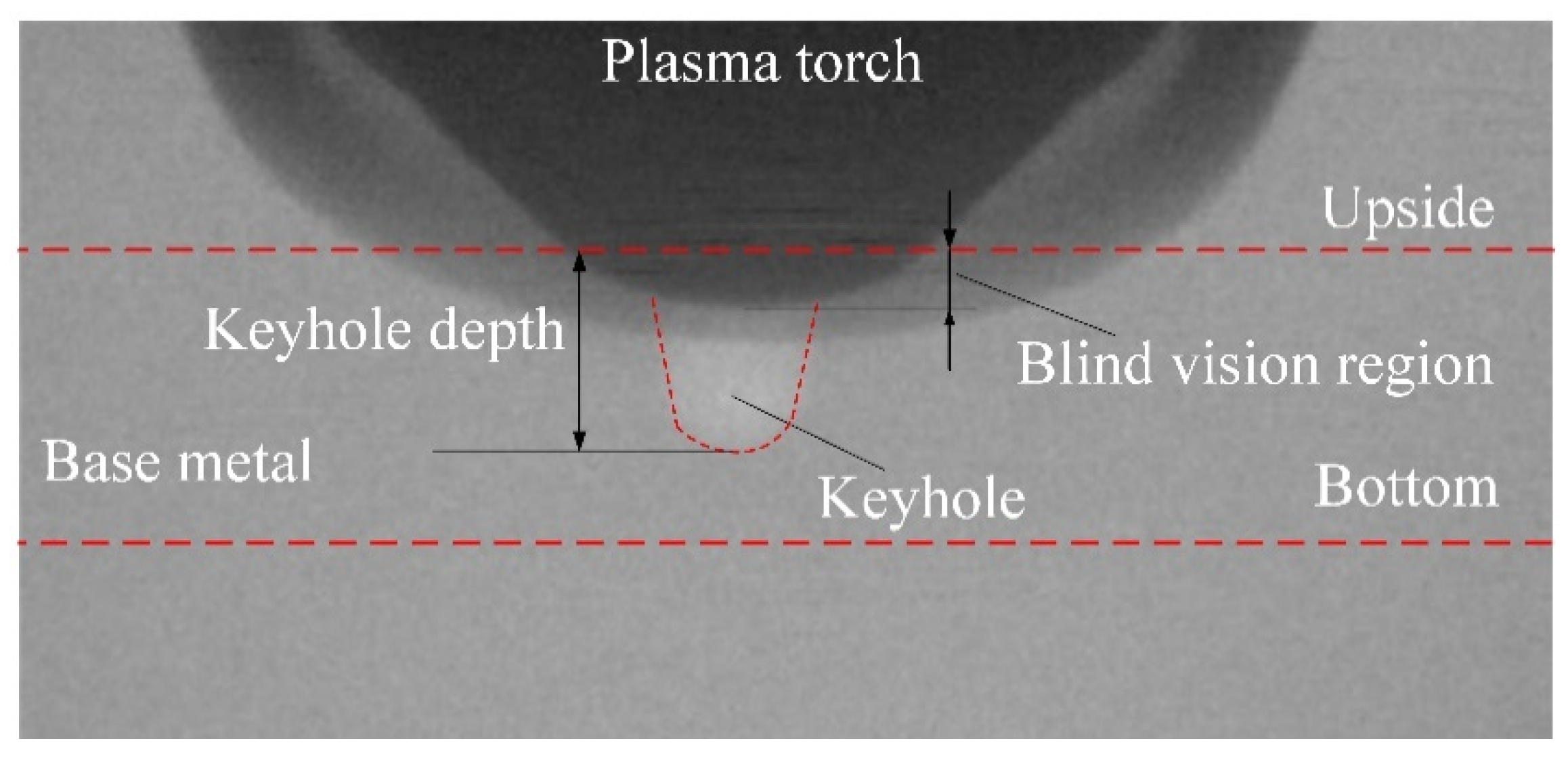



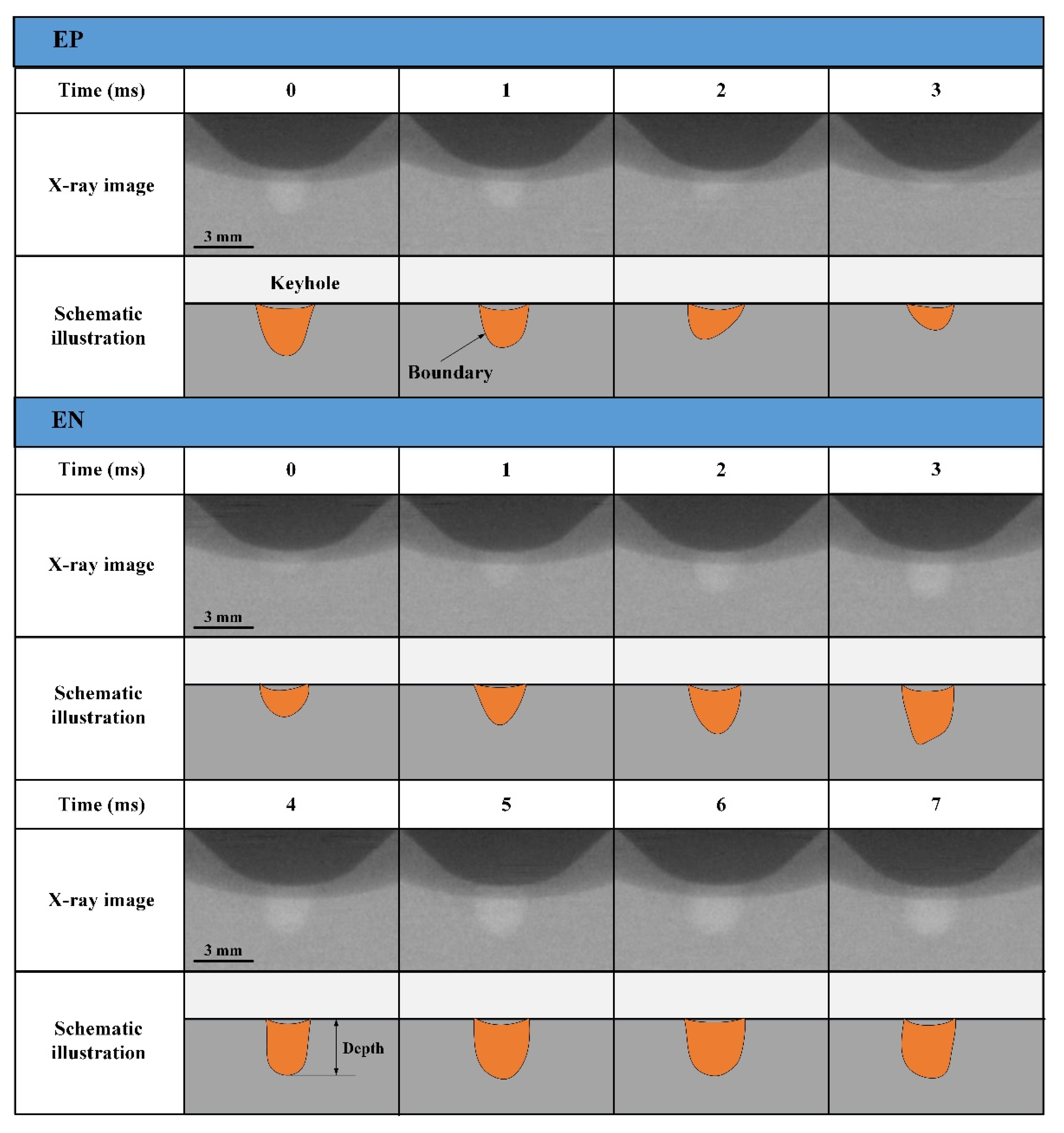
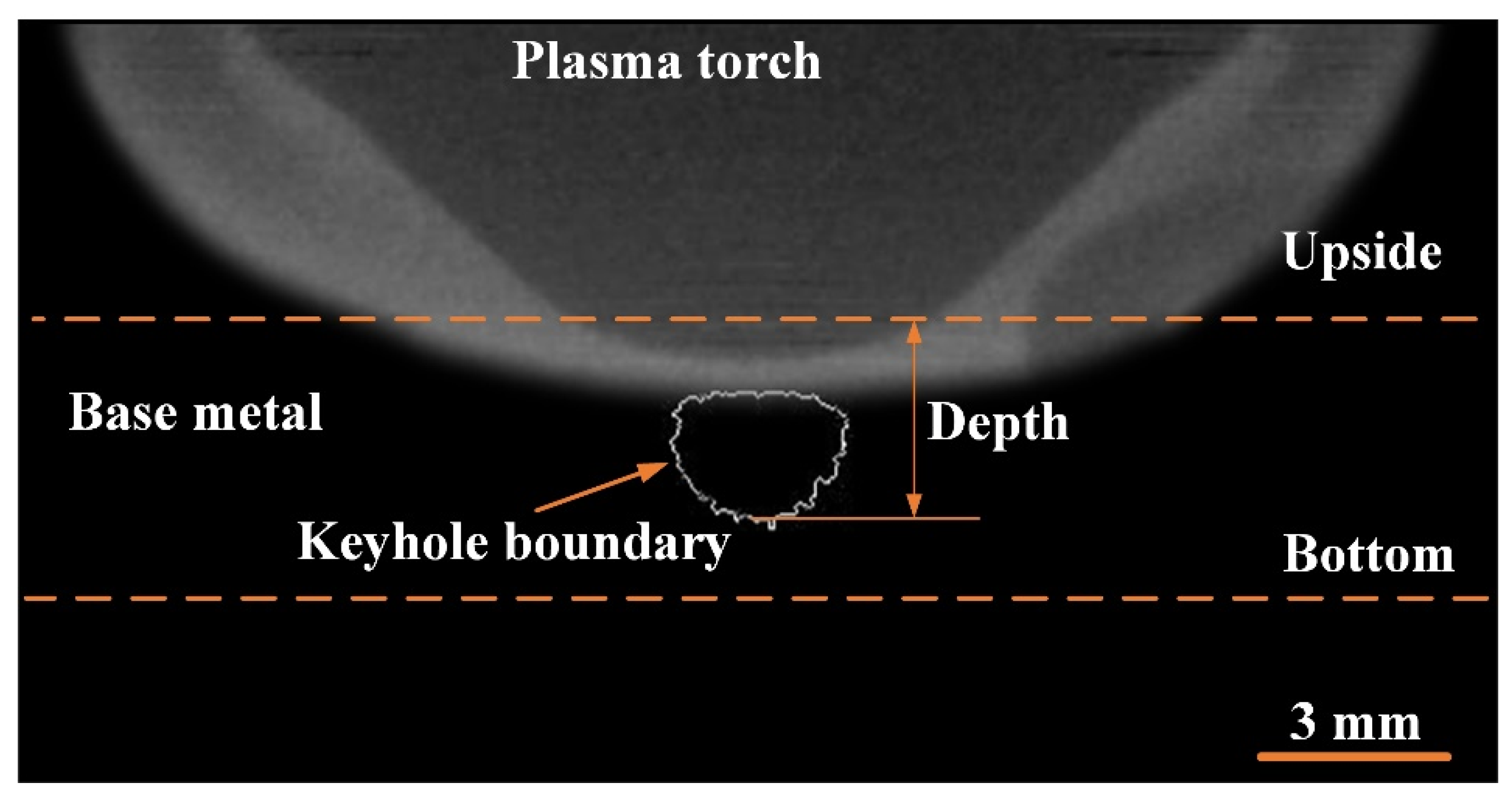




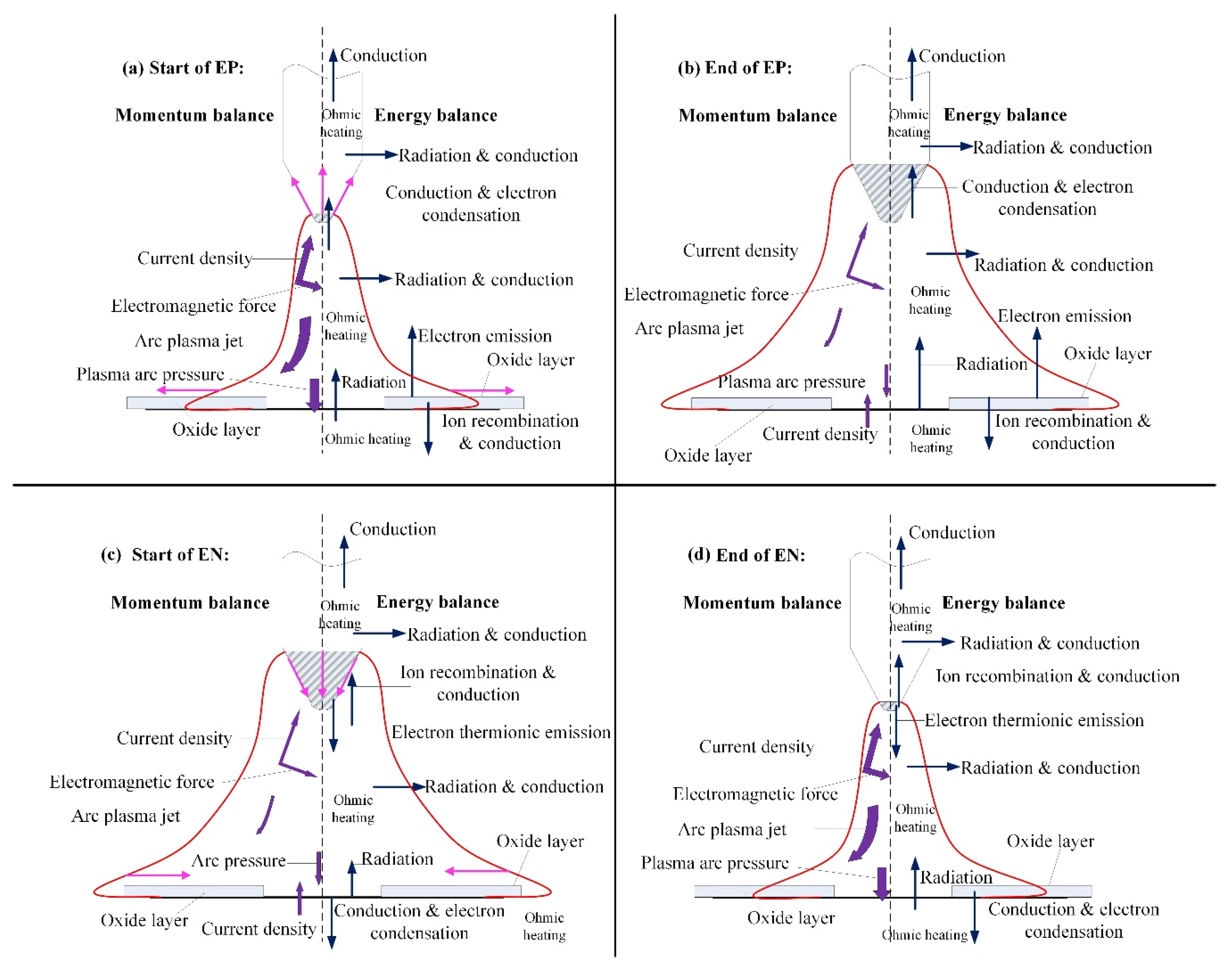
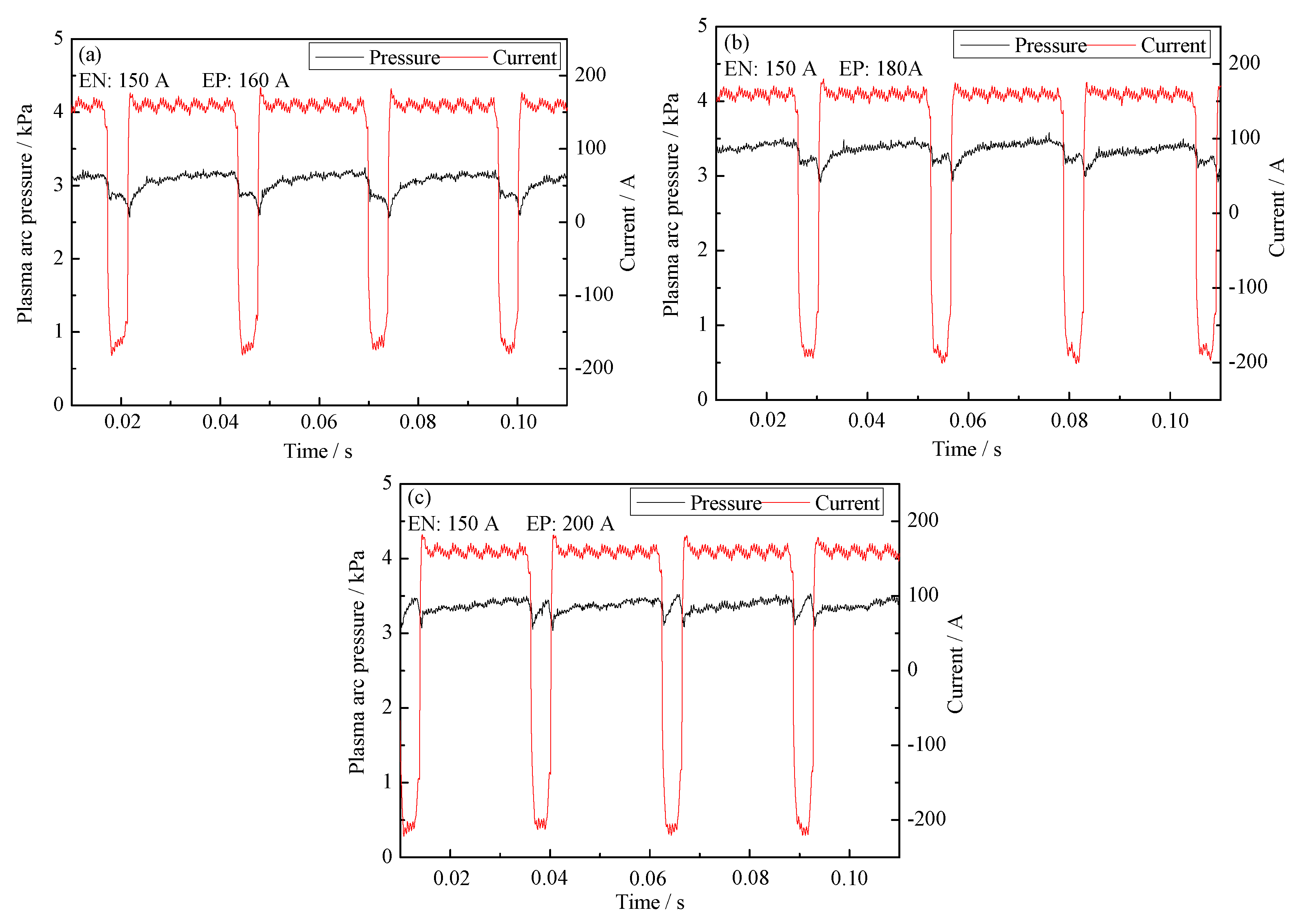
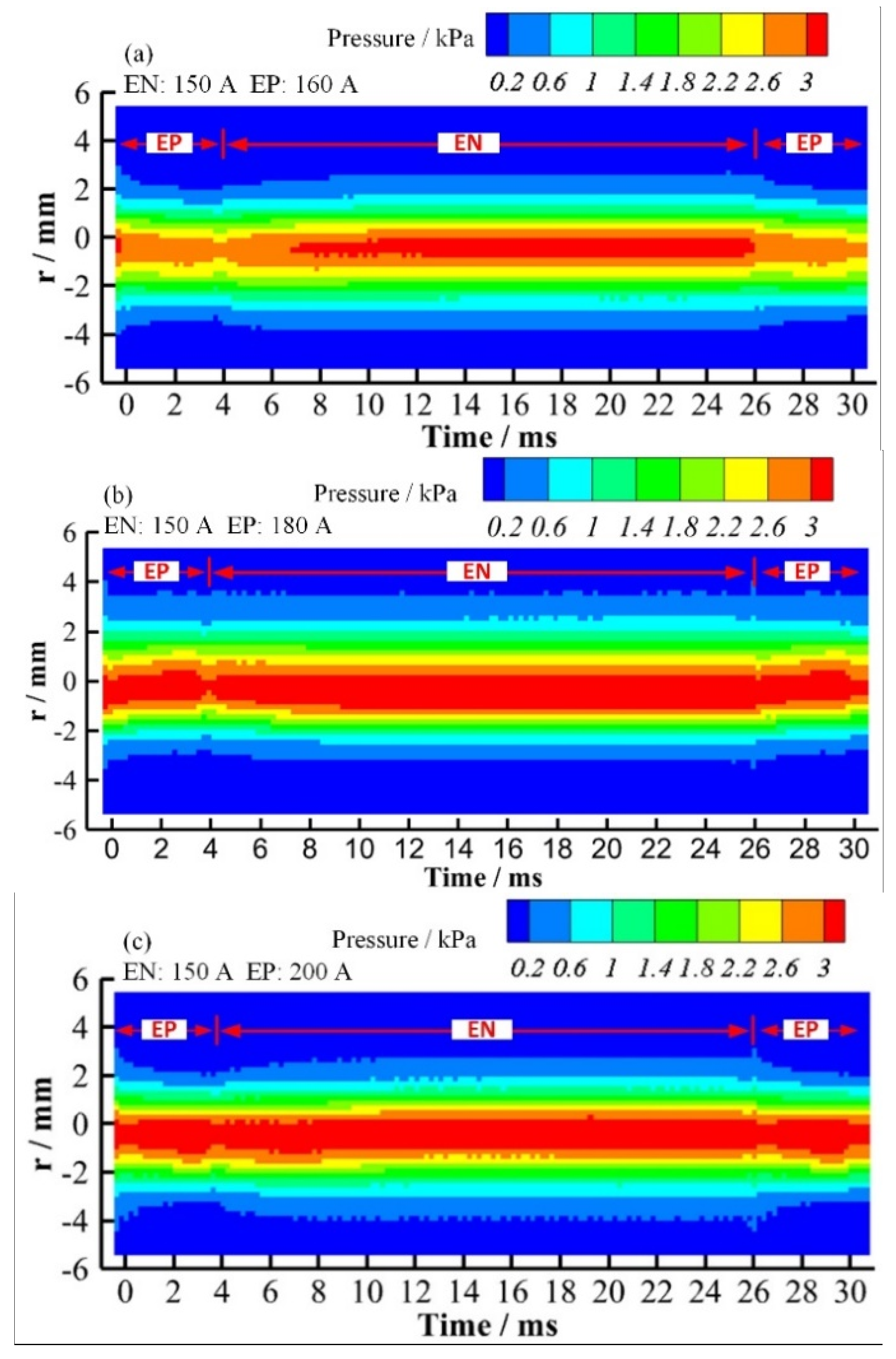

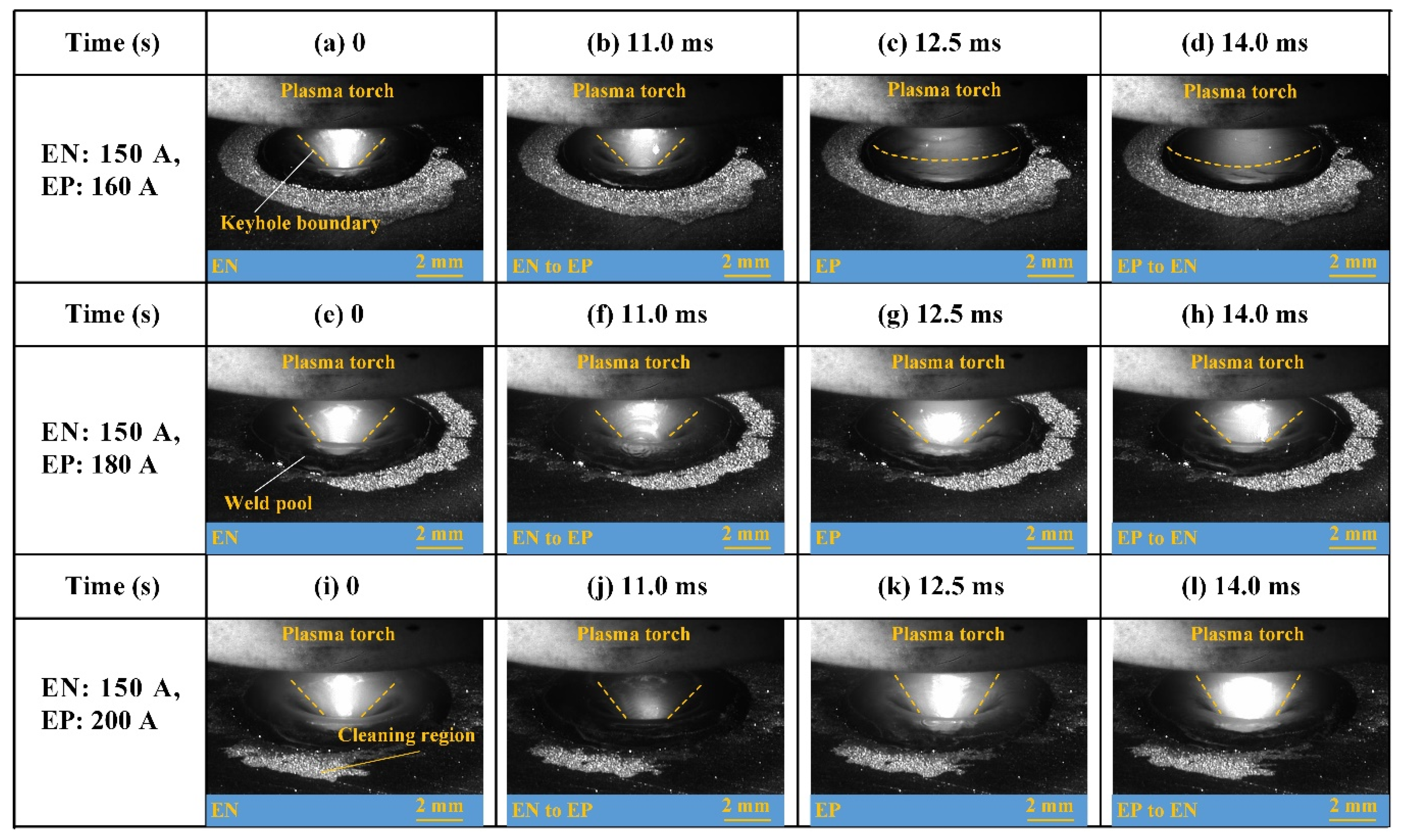
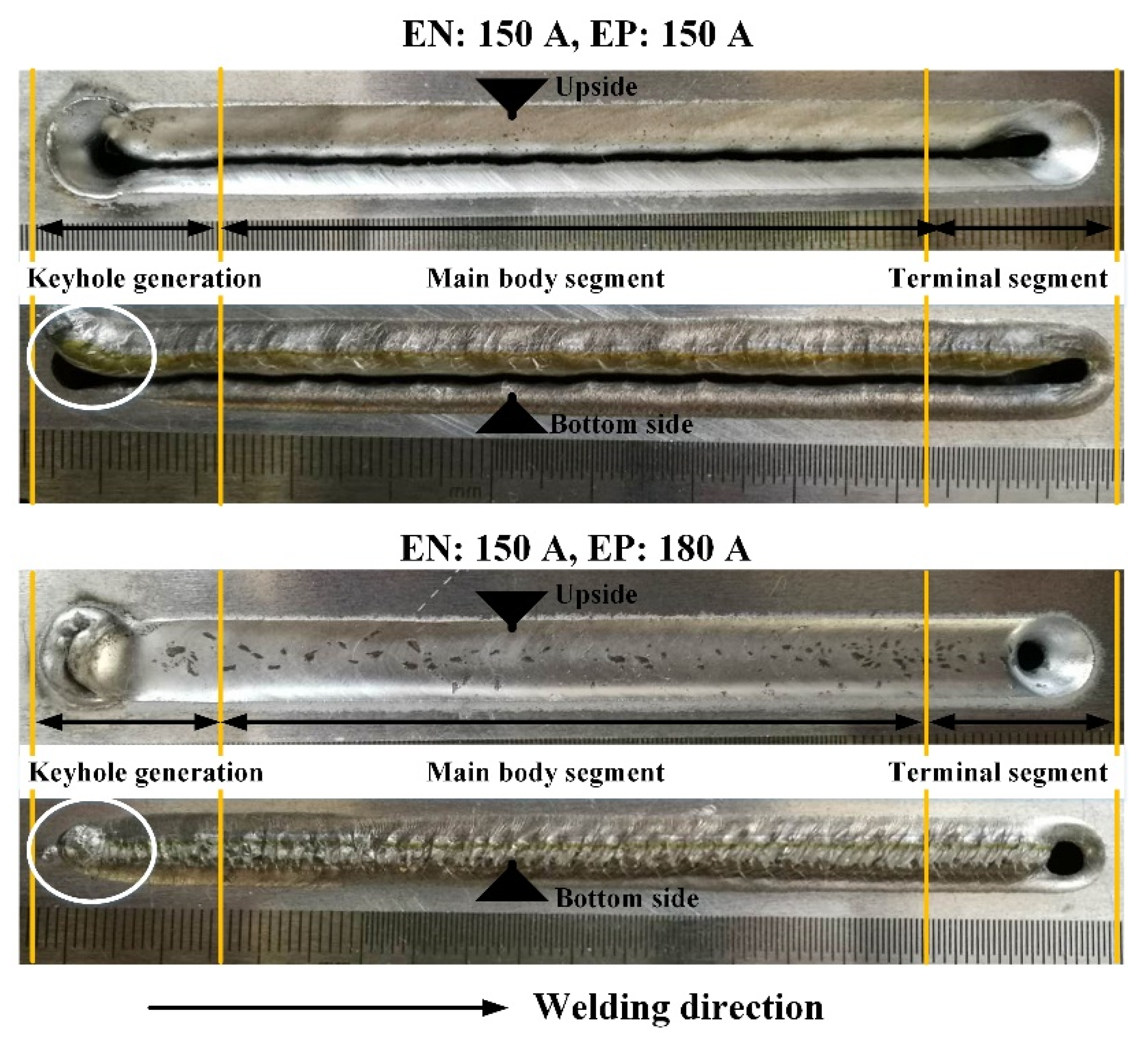
| Si | Fe | Cu | Mn | Mg | Cr | Zn | Al |
|---|---|---|---|---|---|---|---|
| <0.25 | <0.40 | <0.10 | <0.10 | 2.2–2.8 | 0.15–0.35 | <0.10 | balance |
| Process Parameter | Value | Unit |
|---|---|---|
| Tungsten diameter | 4.8 | mm |
| Nozzle diameter | 3.2 | mm |
| Plasma gas flow rate | 2.0 | L/min |
| Shielding gas flow rate | 10 | L/min |
| Current of EP | 150 | A |
| Current of EN | 150 | A |
| Duration of EP | 4 | ms |
| Duration of EN | 21 | ms |
| The standoff | 4 | mm |
| Tungsten setback | 4 | mm |
© 2019 by the authors. Licensee MDPI, Basel, Switzerland. This article is an open access article distributed under the terms and conditions of the Creative Commons Attribution (CC BY) license (http://creativecommons.org/licenses/by/4.0/).
Share and Cite
Xu, B.; Tashiro, S.; Jiang, F.; Chen, S.; Tanaka, M. Effect of Arc Pressure on the Digging Process in Variable Polarity Plasma Arc Welding of A5052P Aluminum Alloy. Materials 2019, 12, 1071. https://doi.org/10.3390/ma12071071
Xu B, Tashiro S, Jiang F, Chen S, Tanaka M. Effect of Arc Pressure on the Digging Process in Variable Polarity Plasma Arc Welding of A5052P Aluminum Alloy. Materials. 2019; 12(7):1071. https://doi.org/10.3390/ma12071071
Chicago/Turabian StyleXu, Bin, Shinichi Tashiro, Fan Jiang, Shujun Chen, and Manabu Tanaka. 2019. "Effect of Arc Pressure on the Digging Process in Variable Polarity Plasma Arc Welding of A5052P Aluminum Alloy" Materials 12, no. 7: 1071. https://doi.org/10.3390/ma12071071





